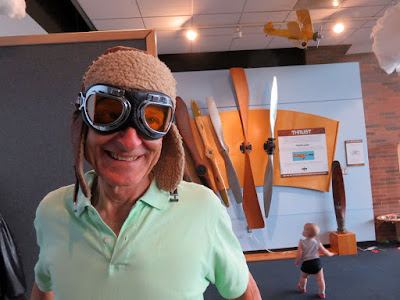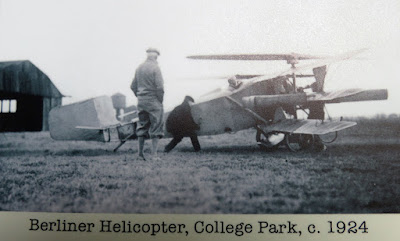 |
| My grandchild is on the loose as I try on a helmet and goggles. |
Start with the fact that it is on the grounds of the world's oldest continuously operating airport, located outside Washington, D.C., in Maryland. Wilbur Wright chose this location for the airport in 1909, initially as a place to train America's first military aviators.
True to say, that was only the beginning for College Park Airport.
The first woman to fly as a passenger in the U.S. went up here, in 1909. She was Sarah Van Deman. There was no seat belt, but a string was tied around her skirt to keep it in place. Wilbur Wright was her pilot.
He was the first to fly over the U.S. Capitol, took up the first Congressman to fly and also moonlighted as a stunt pilot in silent films, earning his nickname (it stood for "Happy") in the process. Hap trained new military pilots here, and went on to command the Army Air Corps, leading it in World War II.
The first Postal Airmail Service operations would begin here, in 1918. The airmail's hangar and its large compass rose ground marker remain. The airport's code "CGS" originally stood for the airmail's "ColleGe Station" of the 1930s.
first controlled helicopter flight took place at College Park, in 1924. Father and son Emile and Henry Berliner created a complicated looking machine, nothing like what we consider a helicopter today — they didn't even call it a "helicopter."
 |
| The 1924 Berliner Helicoplane. |
Incredibly, one of the Berliner machines survives and is at the College Park Aviation Museum on loan from the Smithsonian's Air and Space Museum.
Built from a World War I surplus Nieuport 23 fighter plane, the "Helicoplane" uses two massive counter-rotating propellers above the wings for lift. A small propeller atop the rear fuselage tilts the machine slightly up or down, causing the downward force of the main props to move it forward or backwards.
 |
| Main rotor atop each wing provided lift. Louvers allowed it to bank for tuns. |
The triplane wings allowed gliding in case of engine failure, but with them in place the Berliner could not auto-rotate to land, a safety feature of helicopters and autogiros. More striking, the Berliner's motor wasn't powerful enough to lift the thing out of its own ground-effect down wash — about 15 feet!
 |
| Fuselage is cut away to show drive mechanism of small control rotor. Note the tail skid, sprung with wrapped bungee cord. |
My favorite part of College Park's aviation history, though, is its link to the ERCO Ercoupe. Henry Berliner founded the Engineering and Research Corp. (ERCO) in 1937 and tested its airplanes at College Park Airport.
Chief among these was the Ercoupe, a lovely little two-seater with twin tails, intended to be a safe and easy airplane anybody could fly. Indeed, there are stories of children flying them.
 |
| Meant to be the plane for everybody, the Ercoupe was clean, cute, and unwanted. |
ERCO naturally expected flyers returning from World War II to want to go on flying, and began full-scale manufacturing in 1945. It began full-scale marketing, too — you could buy one at Macy's.
It was a bust. Veterans wanted families, homes and automobiles, not airplanes. Production of the type continued fitfully by other manufacturers, up to 1970, but the Ercoupe never became everyone's airplane.
There are other great planes on display at the College Park Aviation Museum, including the barnstorming JN-4 Jenny that taught America to love aviation. But the Ercoupe continues to spark my imagination.
Like so much else, it all started at College Park.




























Neat article.
ReplyDeleteMotorcycles are the next best thing to flying!
ReplyDelete